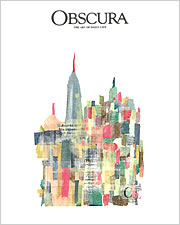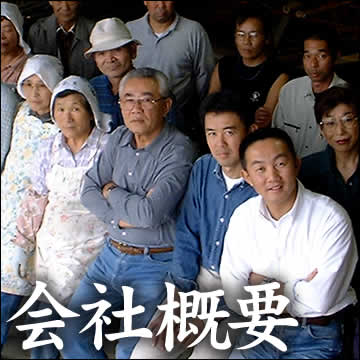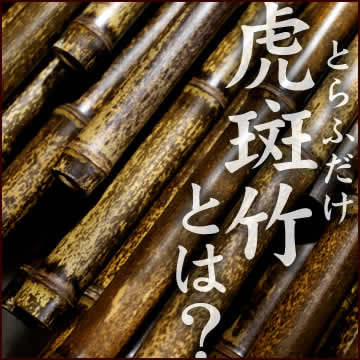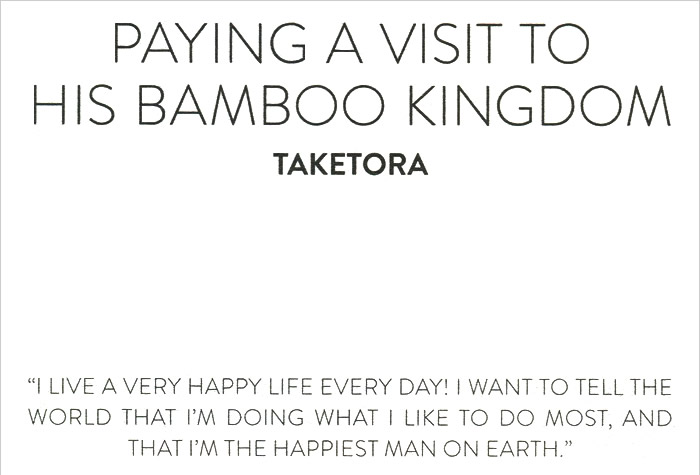
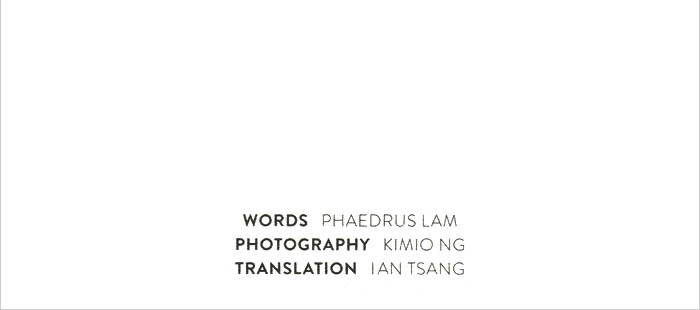
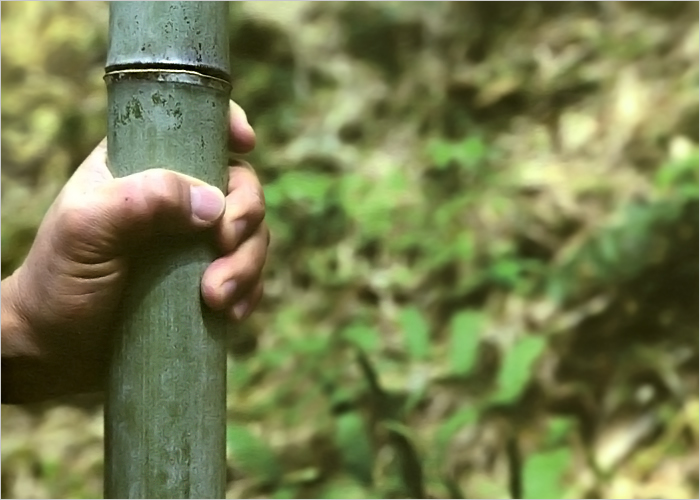
PAYNG A VISIT TO HIS BAMBOO KINGDAM
彼の竹王国を訪ねる
TAKETORA
竹虎
"I LIVE A VERY HAPPY LIFE EVERY DAY! I WANT TO TELL THE WORLD THAT I'M DOING WHAT I LIKE TO DO MOST,AND THAT I'M THE HAPPIEST MANON EARTH".
WARDS PHAEDRUS LAM
OHITIGRAPHY KIMIO NG
TRANSLATION IAN TSANG
僕は毎日幸せに生きています!僕は一番好きなことをしている、世界一の幸せ者だと伝えたいです。
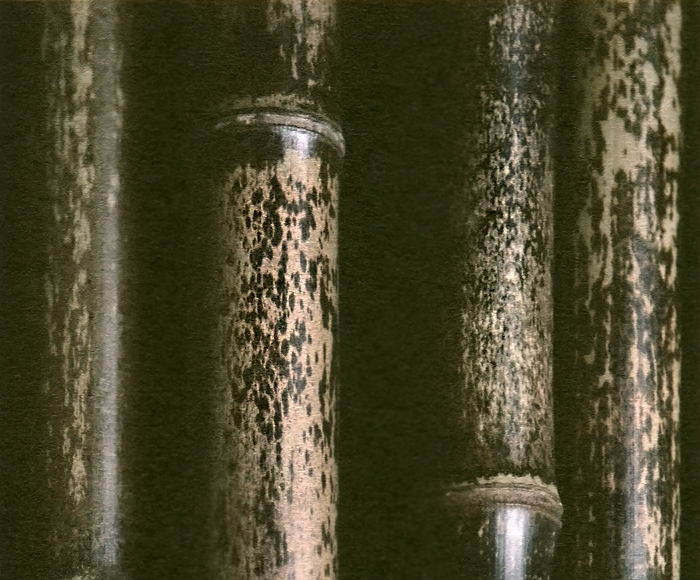
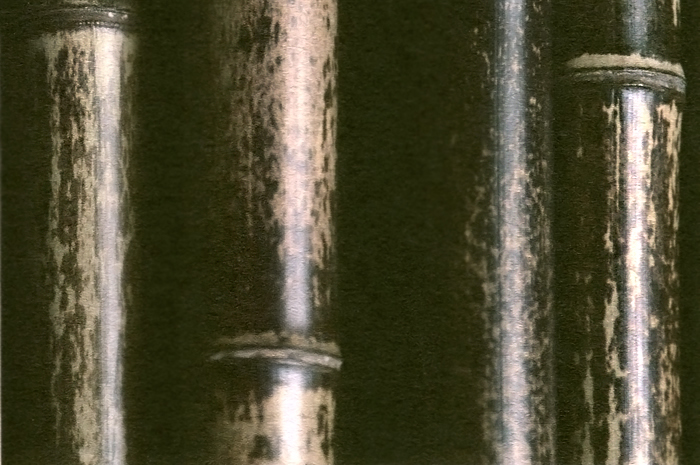
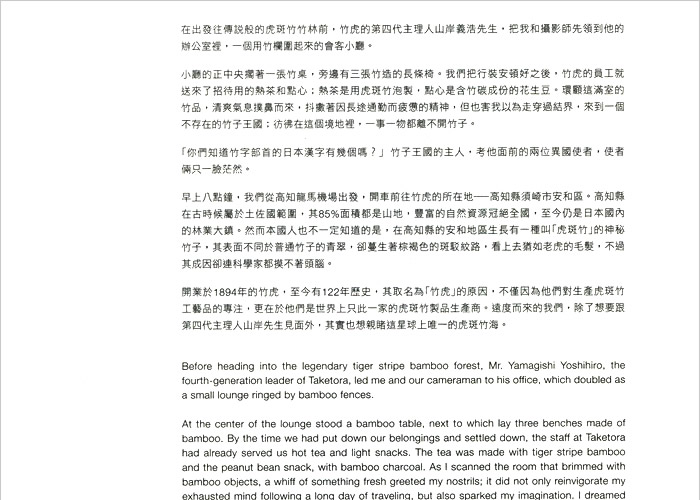
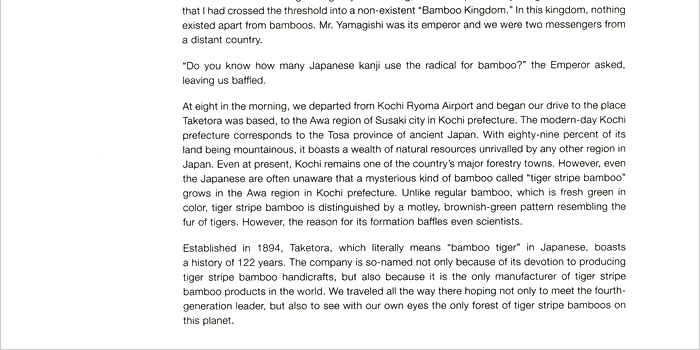
Before heading into the legendary tiger stipe bamboo forest, Mr. Yamagishi Yoshihiro, the fourth-generation leader of Taketora, led me and our cameraman to his office, which doubled as a small lounge ringed by bamboo fences.
At the center of the lounge stood a bamboo table, next to which lay three benches made of bamboo. By the time we had put down our belongings and settled down, the staff at Taketora had already served us hot tea and light snacks. The tea was made with tiger stripe bamboo and the peanut bean snack, with bamboo charcoal. As I scanned the room that brimmed with bamboo objects, a whiff of something fresh greeted my nostrils; it did not only reinvigorate my exhausted mind following a long day of traveling, but also sparked my imagination. I dreamed that I had crossed the threshold into a non-existent "Bamboo Kingdom." In this kingdom, nothing existed apart from bamboos. Mr. Yamagishi was its emperor and we were two messengers from a distant country.
"Do you know how many Japanese kanji use the radical for bamboo?" the Emperor asked, leaving us baffled.
At eight in the morning, we departed from Kochi Ryouma Airport and began our drive to the place Taketora was based, to the Tosa province of ancient Japan. With eigty-nine percent of its land being mountainous, it boasts a wealth of natural resources unrivalled by any other region in Japan. Even at present, Kochi remains one of the country's major forestry towns. However, even the Japanese are often unaware that a mysterious kind of bamboo called "tiger stripe bamboo" grows in the Awa region in Kochi prefecture. Unlike regular bamboo, which is fresh green in color, tiger stripe bamboo is distinguished by a motley, brownish-green pattern resembling the fur of tigers. However, the reason for its formation baffles even scientists.
Established in 1894, Taketora, which literally means "bamboo tiger" in Japanese, boasts a history of 122 years. The company is so-named not only because of its devotion to producing tiger stipe bamboo products in the world. We traveled all the way there hoping not only to meet the fourth-generation leader, but also to see with our own eyes the only forest of tiger stripe bamboos on this planet.
幻の虎斑竹の竹林で先頭を行くのは山岸義浩氏、竹虎四代目は私とカメラマンを竹虎本社の竹に囲まれた小さなラウンジへと導きました。
ラウンジの真ん中にはテーブルがあり、隣には竹製の三つの椅子が並んでいました。私たちが荷物を置いて落ち着いたときには、竹虎のスタッが熱いお茶とお菓子を用意してくれていました。虎斑竹から作られたお茶と、竹炭を使ったピーナッツのお菓子です。竹であふれた部屋を見るにつれて、爽やかな香りが鼻孔に漂ってきました。それが長い一日に疲れた私の心に活力取り戻すだけではなく、私の想像力に火をつけたのです。私は実在しない「竹の王国」の境界を越える夢を見ました。その王国には竹に関わらないものはありません。山岸氏はそこの皇帝で、私たちは遠い国から来た二人の使者なのです。
「竹かんむりのつく漢字が日本でどれだけ多くあるか知っていますか?」皇帝は尋ね、困惑する私たちを後にしました。
朝の8時、私たちは 高知龍馬空港から離れ、竹虎のある須崎市安和(昔の日本の土佐)とドライブを開始しました。高知県の89%は森林と言われている山の多い県であり、日本の他の地域にも追随を許さない、豊かな自然を誇っています。現在でも高知県は国の主要な林業の地域の一つです。しかしながら、日本人は虎斑竹と呼ばれる神秘的な種類の竹が高知県の安和地域で育つということを知りません。新緑色の多くの竹とは異なり、虎斑竹は虎の毛皮に似た茶色がかった緑色の模様で区別されます。しかし、虎模様が浮かぶ理由は科学者たちさえ悩ませています。
1894年に創業された竹虎は、122年の歴史を誇っています。その社名は文字通り日本語で「竹の虎」ですが、そればかりではありません。私たちの旅の目的は竹虎四代目に会うことだけではなく、私たち自身の眼で世界にただ一つの虎斑竹の竹林を見ることでした。
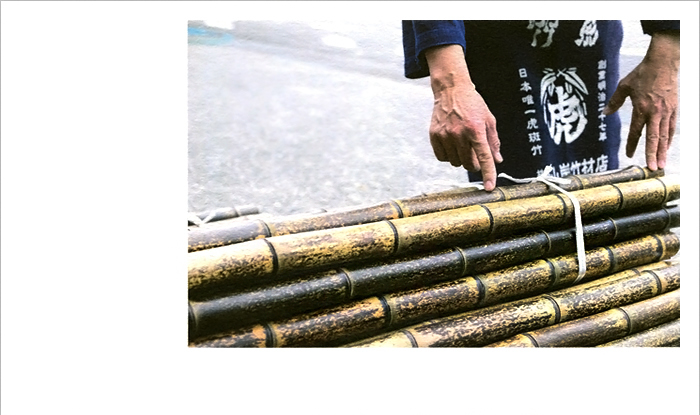
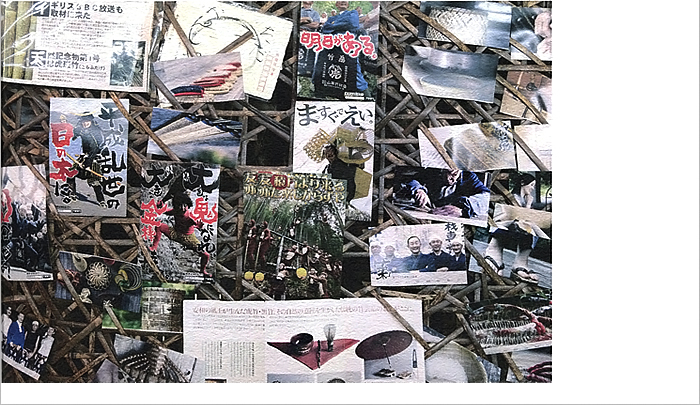
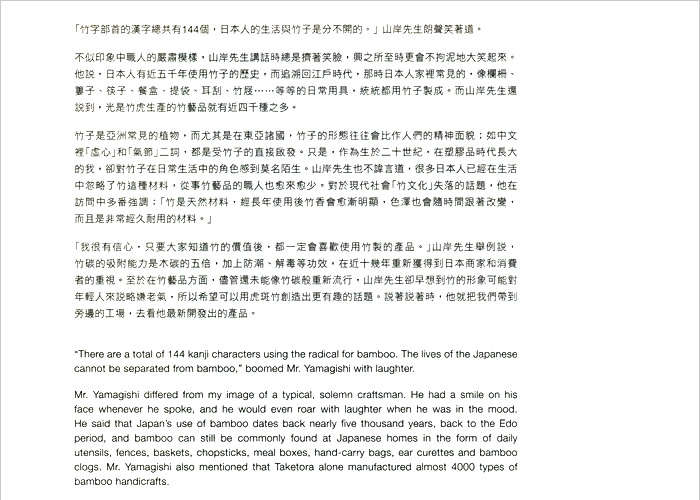
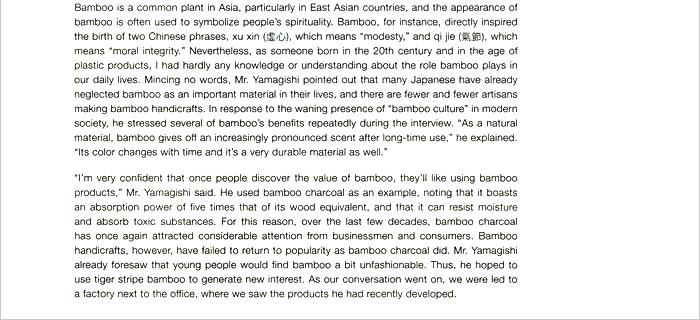
"There are a total of 144 kanji characters using the radical for bamboo. The lives of the Japanese cannot be separated from bamboo. " boomed Mr. Yamagishi with laughter.
Mr. Yamagishi differed from my image of typical, solemn craftsman. He had a smile on his face whenever he spoke, and he would even roar with laughter when he was in the mood. He said that Japan's use of bamboo dates back nearly five thousand years, back to the Edo period, and bamboo can still be commonly found at Japanese homes in the form of daily utensils, fences baskets, chopsticks, meal box, hand-carry bags, ear curettes and bamboo clogs. Mr. Yamagishi also mentioned that Taketora alone manufactured almost 4000 types of bamboo handicrafts.
Bamboo is a common plant in Asia, particularly in East Asian countries, and the appearance of bamboo is often used to symbolize people's spirituality. Bamboo, for instance, directly inspired the birth of two Chinese phrases, xu xin (?心), which means "modesty." And qi jie (氣節),which means "moral integrity." Nevertheless, as someone born in the 20th century and the age of plastic products, I had hardly any knowledge or understanding about the role bamboo plays in our daily lives. Mincing no words, Mr. Yamagishi pointed out that many Japanese have already neglected bamboo as an important material in their lives, and here are fewer and fewer artisans making bamboo handicrafts. In response to the waning presence of "bamboo culture" in modern society, he stressed several of bamboo's benefits repeatedly during the interview. "As a natural material, bamboo gives off an increasingly pronounced scent after long-time use," he explained.〝Its color changes with time and it's a very durable material as well."
"I'm very confident that once people discover the value of bamboo, they'll like using bamboo products," Mr. Yamagishi said. He used bamboo charcoal as an example, nothing that it boasts absorption power five times that of its wood equivalent, and that it can resist moisture and absorb toxic substances. For this reason, over the last few decades, bamboo charcoal has once again attracted considerable attention from businessmen and consumers. Bamboo handicrafts, however, have failed to return to popularity as bamboo charcoal did. Mr. Yamagishi already foresaw that young people would find bamboo a bit unfashionable. Thus, he hoped to use tiger stripe bamboo to generate new interest. As our conversation went on, we were led to a factory next to the office. Where we saw the products he had recently developed.
「全部で144文字の漢字が竹を部首としています。日本人の生活から竹を切り離すことはできません」山岸氏は景気よく笑いました。
山岸氏は私の中の典型的な厳めしい職人のイメージとは異なっていました。彼はいつでも笑顔で話をし、気分により大声で笑っていました。彼が言うには、日本人の竹の利用は5000年をさかのぼり、江戸時代ではまだ、塀、籠、箸、食器、手提げ鞄、耳かきや竹下駄など一般家庭でも使われていました。山岸氏もまた、竹虎だけでほぼ4000種類の竹工芸品を取り扱っているというのです。
竹は特に東アジア諸国で一般的な植物であり、人々の精神を象徴するためにも多く使われます。例えば二つの中国語の誕生に直接影響を与えており、シュシン(?心)は「謙虚さ」を意味します。そしてシージェ(氣節)の意味は「道徳的な整合性」です。それにもかかわらず、20世紀そしてプラスチックの時代生まれの私は、日常生活の中で竹の役割についてほとんどの知識と理解を持っていませんでした。率直に言うと、山岸氏が指摘するには多くの日本人はすでに生活の中で重要な素材としての竹に無関心であり、現在は竹工芸品を作る職人が減り続けています。現代社会における「竹文化」の存在の衰退に応え、彼は繰り返しインタビューの中で竹の利点のいくつかを強調しました。「自然の材料として、竹は長い間使うことでますます熟成する。」と彼は説明ました。「時間とともに色の変化する、また非常に耐久性もある素材なのです。」
「人々が竹の価値に気づけば、彼らは竹製品を使うことが好きになると僕は自信を持っています。」と山岸氏は言いました。彼は例として、竹炭が同量の木炭と比べて吸着力が5倍を誇ることや、湿気対策に使えること、有害物質を吸着する他にはないものとして挙げました。このため、近年竹炭は商業者や消費者からの注目を再び集めているのです。しかしながら竹工芸品は、竹炭のように人気を取り戻すことは出来ませんでした。山岸氏は若い人たちはほんの少し流行おくれの竹を見出すだろうと予見しています。このように、彼は新しい関心を作り出すために虎斑竹を用いることに期待しています。会話を続けながら、私たちは竹虎の隣の工場へと移動しました。そこで彼が最近開発した製品を見たのです。
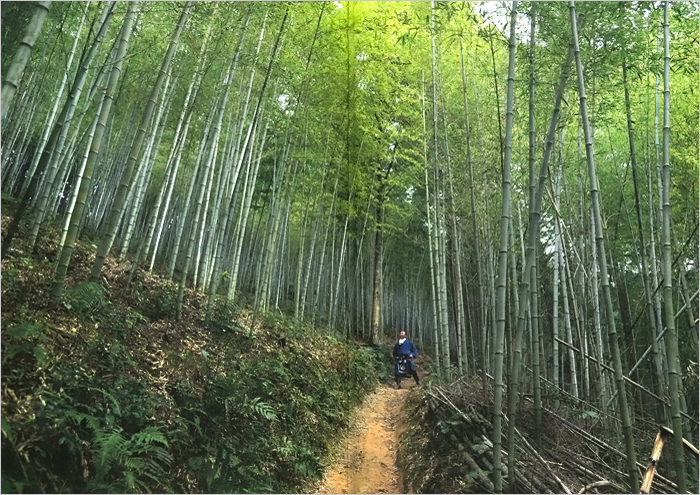
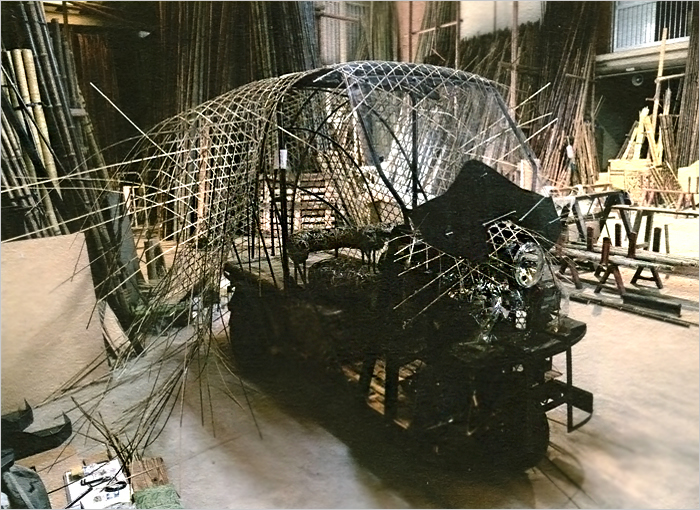
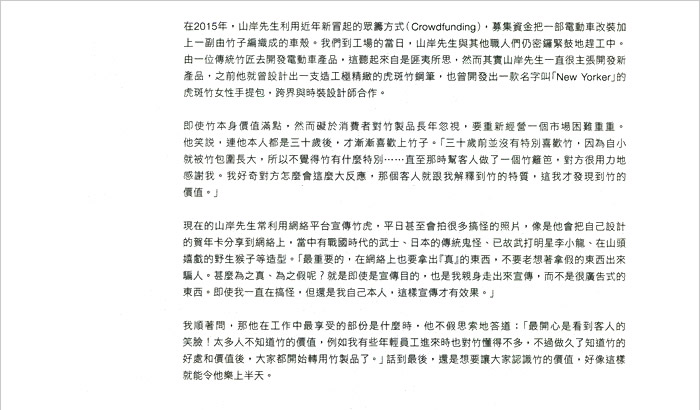
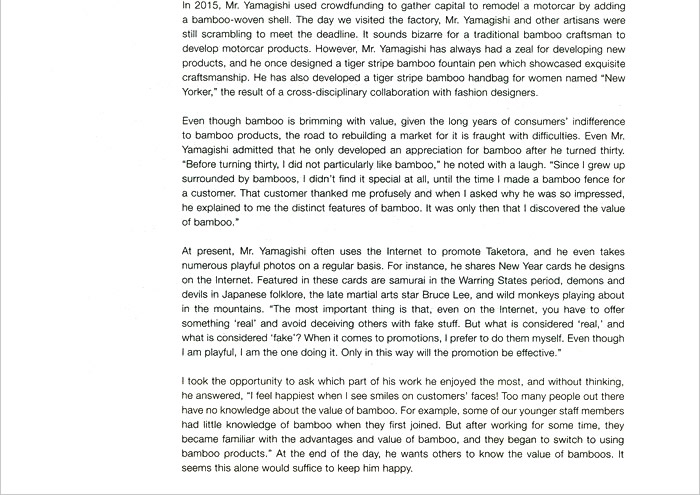
In 2015, Mr. Yamagishi used crowdfunding to gather capital to remodel a motorcar by adding a bamboo-woven shell. The day we visited the factory, Mr. Yamagishi and other artisans were still scrambling to meet the deadline. It sounds bizarre for a traditional bamboo craftsman to develop motorcar products. However, Mr. Yamagishi has always had a zeal for developing new craftsmanship. He has also developed a tiger stripe bamboo handbag for women named "New Yorker," the result of a cross-disciplinary collaboration with fashion designers.
Even though bamboo is brimming with value, given the long years of consumers' indifference to bamboo products, the road to rebuilding a market for it is fraught with difficulties. Even Mr. Yamagishi admitted that he only developed an appreciation for bamboo after he turned thirty. "Before turning thirty, I did not particularly like bamboo." He noted with a laugh. "Since I grew up surrounded by bamboos, I didn't find it special at all, until the time I made a bamboo fence for a customer. That customer thanked me profusely and when I asked why he was so impressed, he explained to me the distinct features of bamboo. It was only then that I discovered the value of bamboo. "
At present, Mr. Yamagishi often uses the Internet to promote Taketora, and he even takes numerous playful photos on a regular basis. For instance, he shares New Year cards he designs on the Internet. Featured in these cards are samurai in the warring States period, demons and devils in Japanese folklore, the late martial arts star Bruce Lee, and wild monkeys playing about in the mountains. "The most important thing is that, even on the Internet, you have to offer something `real` and avoid deceiving others with fake stuff. But what is considered `real,` and what is considered `fake`? When it comes to promotions, I prefer to do them myself. Even though I am playful, I am the one doing it. Only in this way will the promotion be effective. "
I took the opportunity to ask which part of his work he enjoyed the most, and without thinking, he answered, "I feel happiest when I see smiles on customers' faces! Too many people out there have no knowledge about the value of bamboo. For example, some of our younger staff members had little knowledge of bamboo when they first joined. But after working for some time, they became familiar with the advantages and value of bamboo, and they began to switch to using bamboo products." At the end of the day, he wants others to know the value of bamboos. It seems this alone would suffice to keep him happy.
2015年、山岸氏は自動車に竹編みの外装を加える改造をする資金を集めるために、クラウドファンディングを使用しました。私たちが工場を訪問した日は、山岸氏と職人たちは締め切りに間に合わせるため依然として奮闘していました。伝統的な竹職人が自動車を開発するというのは奇妙に聞こえます。しかし、山岸氏は新しい技術を開発することに常に熱意を持っていました。彼はまた、"ニューヨーカー"名付けられた, 虎斑竹の女性用ハンドバックをファッションデザイナーとの協力の結果、開発しました。
竹は価値に満ちているにも関わらず、竹製品に消費者たちが長年無関心であったことから、市場を再構築する道は困難に満ちています。山岸氏でさえ、竹へ感謝したのは30歳を過ぎてからだと明かしました。「30歳で変わる前は、僕はたいして竹が好きではなかったのです」彼は笑いながら言いました。「竹に囲まれて育ったので、お客様に竹垣を作るまでは竹の特別性を見つけることができませんでした。そのお客様は僕にとても感謝していて、どうしてそれほど感動しているのか尋ねると、竹の際立った特徴を説明してくれたんです。それで僕は竹の価値を見いだせたのです。」
現在では、山岸氏はしばしば竹虎を売り込むためにインターネットを使用し、定期的に遊び心のある沢山の写真を撮ります。たとえば、彼はインターネットで彼のデザインした年賀状を公開しています。紹介されている年賀状には戦国時代の武士、日本の民話の鬼、かつての武術家スターであるブルース・リー、そして山で遊ぶ野生の猿があります。「もっとも重要なことは、インターネットでおいても"本物"を提供し、偽物で人を欺いてはいけないということです。では、"本物"は何で、"偽物"は何だと考えられますか?プロモーションを進めるとき、僕は自分自身で行うようにしています。おどけたことをするときでさえ、僕はそれをたった一人でするんです。こうすることで、プロモーションが効果的になるんです」
どんな時、一番仕事が楽しいかを尋ねると、彼は考えずにこう答えました。「僕は、お客様の笑顔を見たときに一番幸せを感じるんです!本当に多くの人たちはそこにある竹の価値を忘れています。たとえば、若いスタッフたちは、入社したときは竹の知識はほんの少ししかありませんでした。けれども、しばらく働いた後には、竹の利点や価値について良く知るようになり、竹製品を使い始めるようになるんです。」一日の終わりに、彼は他の人々も竹の価値を知ることを望んでいます。彼が幸せであり続けるために十分なのは、これだけなのです。
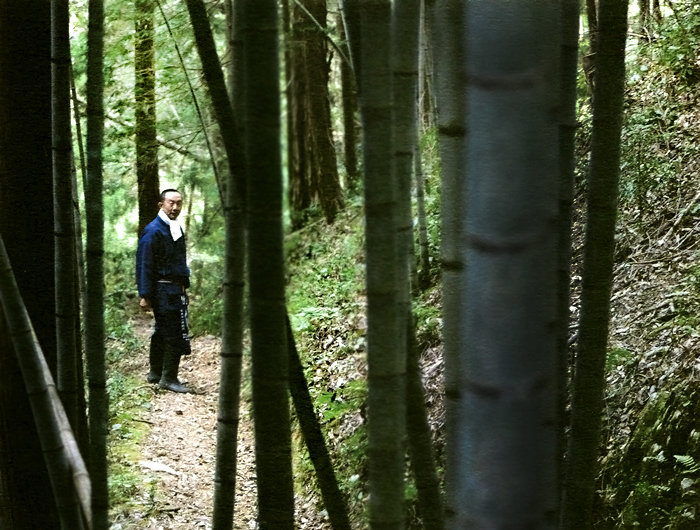
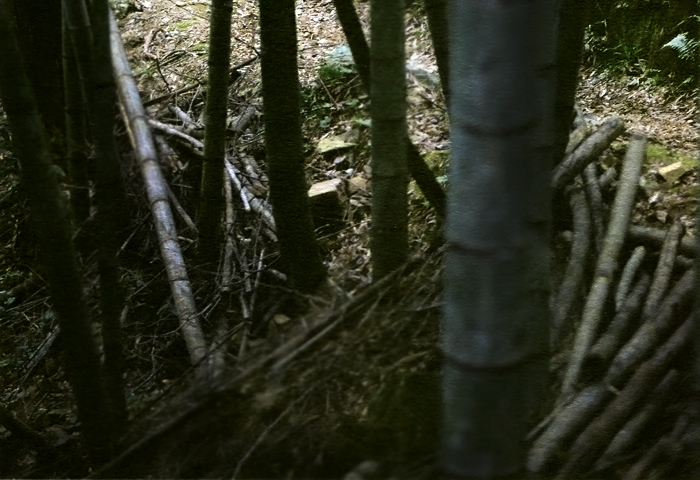
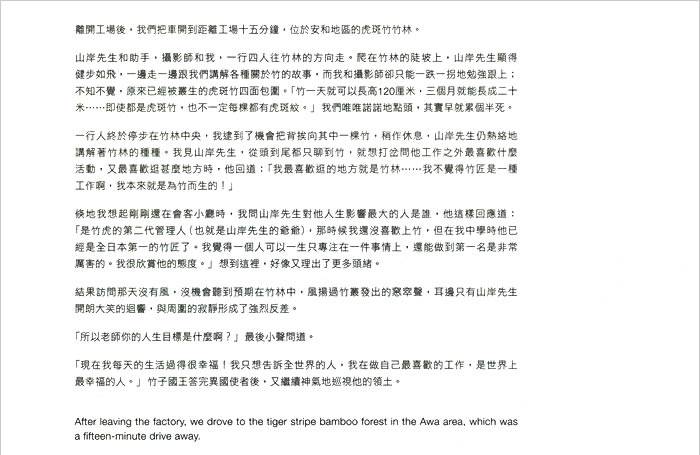
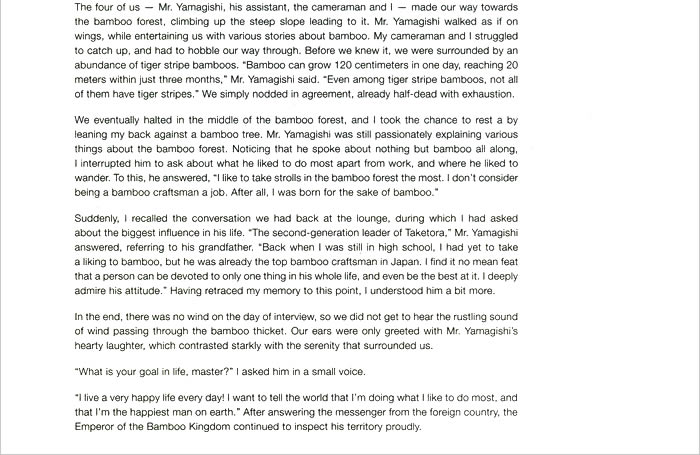
We eventually halted in the middle of the bamboo forest, and I took chance to rest a by leaning my back against a bamboo tree. Mr. Yamagishi was still passionately explaining various things about the bamboo forest. Noticing that he spoke about nothing but bamboo all along, I interrupted him to ask about what liked to do most apart from work, and where he liked to wander. To this, he answered, "I like to take strolls in the bamboo forest the most, I don't consider being a bamboo craftsman a job. After all, I was born for the sake of bamboo."
Suddenly, I recalled the conversation we had back at the lounge, during which I had asked about the biggest influence in his life. "The second- generation leader of Taketora," Mr. Yamagishi answered, referring to his grandfather. "Back when I was still in high school, I had yet to take a liking to bamboo, but he was already the top bamboo craftsman in Japan. I find it no mean feat that a person can be devoted to only one thing in his whole life, and even be the best at it. I deeply admire his attitude." Having retraced to my memory to this point, I under stood him a bit more.
In the end, there was no wind on the day of interview, so we did not get to hear the rustling sound of wind passing through the bamboo thicket. Our ears were only greeted with Mr. Yamagishi's hearty laughter, which contrasted starkly with the serenity that surrounded us.
"What is your goal in life, master?" I asked him in a small voice.
"I live very happy life every day! I want to tell the world that I'm doing what I like to do most, and that I'm the happiest man on earth." After answering the messenger from the foreign country, the Emperor of the Bamboo Kingdom continued to inspect his territory proudly.
工場を後にした後、私たちは車で約15分の場所にある安和にある虎斑竹の竹林に向かいました。
山岸氏は私とカメラマンの手助けをし、竹林への道を作りながら急な斜面を登りました。山岸氏は軽やかに歩き、その間、竹に関するさまざまな話で私たちを楽しませました。カメラマンと私は追いつくのに苦労し、よろよろと道を進んでいきました。気づけば、私たちは沢山の虎斑竹に囲まれていました。「竹は1日に120センチメートル成長し、たった3ヶ月で20メートルに達します。」山岸氏は言いました。「しかし、虎斑竹すべてに虎模様があるわけではありません。」私たちはすでに疲れて半分死んだような状態だったので、ただ頷いて同意しました。
最終的に私たちは竹林の中で立ち止まり、竹に背を預けて休む機会を得ました。山岸氏はさらに竹林について情熱的に様々なことを説明しました。彼が他のことについて話さず、竹のことだけについて語っていたことに気づき、話に割り込んでプライベートで好きなことを尋ねると、彼はどこか困惑しているようでした。このように、彼は答えました。「僕は竹林で散歩をすることが一番好きで、竹職人の仕事について考えないことはありません。結局、僕は竹のために生まれたんです。」
突然、私はラウンジで彼の人生への最大の影響について尋ねたことを思い出した。山岸氏は彼の祖父、竹虎二代目について答えた。「僕が高校生で、まだ竹が好きではなかったとき、祖父は日本で一番の竹職人でした。僕が気づいたのは、「世に生を得るは事を成すにあり」ということ。」この点について私は自分の記憶をたどり、彼をもう少し理解しました。
最後に、その取材の日、まったく風はなかったので私たちは竹林を風が通り抜けるサラサラという音を聞くことができませんでした。 私たちの耳は、周囲を囲む静けさとは全く対照的な、山岸氏の豪快な笑い声で迎えられました。
「社長、あなたの人生の目標はなんですか?」私は彼に小さな声で尋ねました。
「僕は毎日幸せに生きています!僕は一番好きなことをしている、世界一の幸せ者だということを伝えたいです。」 外国からの使者に応えた後、竹王国の皇帝は誇らしげに彼の領土を見下ろしていました。
(雑誌「OBSCURA SPRING&SUMMER 2016/VOL20」より転載)
